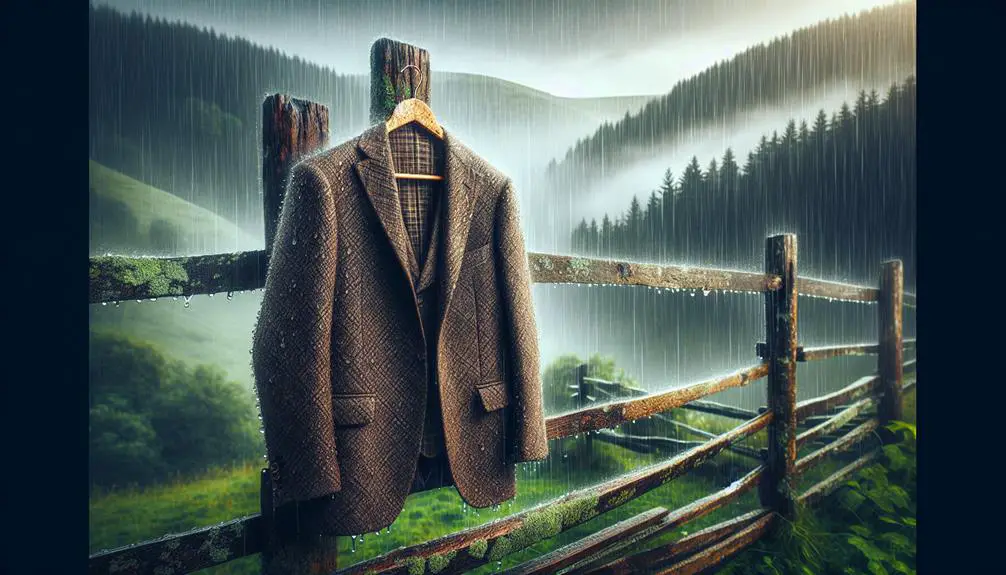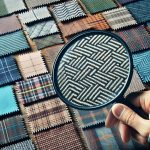I've always been curious about how well tweed holds up against the rain, especially since it's made of wool, which is known for its natural water-resistance. The tight weave and thickness surely add some extra protection, but I wonder how effective these features really are when you're caught in a downpour. I mean, it's great for a misty morning, but what about those unexpected heavy showers? Next, I'm planning to look into whether different types of tweed, like Harris or Donegal, offer varying levels of water resistance. It seems like there might be more to this than meets the eye.
Table of Contents
Key Takeaways
- Tweed's natural waxy coating on wool fibers aids in water repellence.
- The dense, tight weave of tweed fabric increases its water resistance.
- Dyeing processes further tighten the fiber structure, enhancing water impermeability.
- Tweed is not fully waterproof but offers significant protection against moisture.
- Water-repellent treatments can be applied to tweed to boost its resistance to water.
The Origins of Tweed
Tweed, a fabric steeped in history, originated in Scotland during the 18th century. Initially crafted to battle the harsh Scottish weather, it quickly wove its way into the cultural fabric of the region. It's not just any old cloth; it's a symbol of resilience and regional pride. Over time, tweed's rugged charm and practicality caught the eye of the fashion world, leading to its adoption by aristocrats and eventually making its mark on international fashion stages.
The cultural significance of tweed is deeply entwined with Scottish heritage. Historically, different patterns and colors of tweed were used as a form of identity; specific designs were associated with particular clans or regions. This aspect of tweed has persisted, maintaining its role as a cultural emblem while evolving in its fashion applications.
As for its fashion evolution, tweed has shifted from a utilitarian necessity to a staple in high fashion. Designers have reimagined it in countless ways, integrating it with modern styles while preserving its classic appeal. This transformation showcases tweed's versatility and enduring appeal, cementing its status as a timeless piece in the fashion industry.
Tweed's Weaving Process
Let's now look at how tweed is made, starting with its intricate weaving process. Choosing the right fiber is essential, and most often, the choice falls on wool due to its durability and ease of handling. The quality of the wool impacts the texture and the weight of the tweed, so this selection isn't taken lightly. It's all about finding the perfect balance that will lend the fabric its unique characteristics.
Once the fibers are selected, they're spun into yarn. The yarn is then loaded onto the loom. Speaking of loom types, both traditional and modern looms are used in tweed production. Traditional looms, often operated manually, are preferred for creating those unique, intricate patterns tweed is famous for. These patterns aren't just for show; they contribute to the structural integrity of the fabric.
Modern looms, on the other hand, offer quicker production rates and can be used for larger orders. However, even with modern technology, great care is taken to preserve the classic look and feel of tweed. The interplay between loom type and weaving technique is a delicate dance that results in the robust, textured fabric we appreciate.
Natural Water Resistance
Now, I'll explain how the natural structure of tweed gives it its water-resistant properties.
Tweed's ability to resist water stems largely from the fiber characteristics of the wool used to make it. Wool fibers have a natural waxy coating called lanolin, which repels water. This means that drops of water tend to bead up and roll off the surface rather than soaking in.
Additionally, the way tweed is woven plays an essential role. The tight weave of the fabric increases its density and thickness, creating a barrier that slows down water penetration. It's not just about the wool itself, but how the fibers intertwine that boosts the fabric's ability to keep you dry.
Another interesting aspect is how tweed's dye absorption enhances its water resistance. When tweed fabrics are dyed, the absorption of color can actually tighten the fiber's structure. This can decrease the space between fibers, reducing the fabric's permeability to water. So, it's not only the natural elements of the wool but also how it's treated and processed that contribute to tweed's effectiveness in damp conditions.
This combination makes tweed a uniquely durable and protective fabric, especially in wet weather.
Common Types of Tweed
Several varieties of tweed exist, each with unique characteristics and origins. When you're diving into the world of tweed, it's essential to understand the common types available and how their distinct tweed patterns and color variations set them apart.
- Harris Tweed: Known for its robustness and legally protected status, Harris Tweed must be handwoven by islanders in the Outer Hebrides of Scotland. It's celebrated for its rich color variations, which stem from local dyes.
- Donegal Tweed: Originating from County Donegal in Ireland, this tweed is famous for its colorful speckles woven into the fabric. These specks create a multi-dimensional look that's as unique as it's eye-catching.
- Herringbone Tweed: Recognizable by its distinctive V-shaped weaving pattern, herringbone tweed isn't just about texture but also about visual rhythm. It typically features two colors alternated to form a zigzag pattern that's both traditional and timeless.
Each type of tweed brings its own flavor to the table, making the choice of tweed as much about personal style as it's about function. Whether you're looking for something rugged or refined, there's a tweed to suit your needs.
Enhancing Tweed With Treatments
Now, let's discuss how we can enhance tweed's water resistance.
There are several water-repellent treatments available that can really make a difference.
It's also important to know how to maintain your tweed after it's been treated, ensuring it stays effective for longer.
Water-Repellent Finishing Options
To enhance tweed's water resistance, various finishing treatments can be applied. By using chemical coatings and durable sealants, we can greatly boost the fabric's ability to repel water. Here's how you can turn your traditional tweed into a more weather-resistant garment:
- Chemical Coatings: These are applied to the surface of the tweed, creating a barrier that water droplets can't penetrate. It's a quick way to add water resistance without altering the fabric's breathability.
- Durable Sealants: More robust than coatings, sealants provide a stronger, longer-lasting resistance. Ideal for outdoor clothing.
- Wax Treatments: Adding a layer of wax enhances the tweed's texture and gives it a classic, rugged look while also repelling water.
These options let tweed maintain its aesthetic while enhancing functionality.
Maintenance Post-Treatment
After taking care of your tweed with water-resistant finishes, it's crucial to maintain its condition to preserve effectiveness. Here's a straightforward guide on how to do just that, focusing on drying techniques and color retention.
| Maintenance Action | Benefit | Frequency |
|---|---|---|
| Gentle Air Drying | Preserves fabric integrity, prevents shrinkage | After each wash |
| Avoid Direct Sunlight | Protects color retention | Always |
| Cool Iron | Keeps fabric smooth without heat damage | As needed |
| Use Mild Detergent | Maintains treatment effectiveness | Every wash |
| Professional Cleaning | Ensures deep cleaning without damaging treatments | Bi-annually |
Performance in Wet Conditions
Tweed's durability against water is a key factor in its attractiveness for outdoor wear. However, it's critical to understand its limitations and characteristics to really master its use in wet conditions. When it comes to weatherproofing limitations, tweed isn't fully waterproof but water-resistant. This means that while it can handle light drizzles or mist, during a downpour, the fabric will eventually begin to absorb water.
Speaking of moisture absorption characteristics, tweed's traditional weaving makes it denser and thicker, which naturally offers a level of protection against moisture. Yet, once it starts absorbing water, it can become heavier and less comfortable to wear. This can be a downside if you're out for a long period in the rain.
Here's a quick rundown to paint a picture:
- *Light Rain*: Tweed holds up well, keeping you dry and comfortable.
- *Heavy Rain*: The fabric begins to soak, becoming heavier and potentially leading to discomfort.
- *Prolonged Exposure*: Sustained wetness can compromise the fabric's integrity and comfort level.
Understanding these aspects helps in making informed decisions about when and how to wear tweed in various weather conditions.
Maintenance and Care Tips
Now, let's talk about keeping your tweed in top shape.
I'll cover how to clean it properly, store it to avoid damage, and fix any wear and tear that might happen over time.
These tips will help you get the most out of your tweed garments for years to come.
Cleaning Tweed Properly
To maintain your tweed's longevity, it's important to clean it properly using gentle methods. While dry cleaning is an option, it carries risks such as potential shrinkage and alteration of the fabric's texture. Instead, I usually opt for less harsh alternatives. Here's how I handle it:
- Spot Cleaning: For small stains, I dab gently with a mixture of water and mild detergent. It's essential to blot rather than rub to avoid damaging the fibers.
- Airing Out: Often, simply airing tweed outside on a dry day freshens it up without needing a wash.
- Brushing: Using a soft-bristled brush, I regularly remove dust and debris to maintain the fabric's integrity.
These methods ensure my tweed remains pristine and durable.
Storing Tweed Correctly
After discussing how to clean tweed, let's explore the best ways to store it to guarantee it stays in top condition. I've found that maintaining the right environment is essential. Here's a quick guide I use:
| Factor | Ideal Condition | Why It Matters |
|---|---|---|
| Humidity | 40-50% | Prevents mold and fiber rot |
| Temperature | Cool, below 68°F (20°C) | Protects texture and color |
| Ventilation | Well-ventilated area | Keeps fabric fresh |
I always make sure my storage space meets these criteria. It's not just about throwing your jacket on a hanger; it's about giving your tweed the care it deserves. Keeping these factors in check really helps in preserving its quality and longevity.
Repairing Tweed Damage
Let's explore how you can repair damage to your tweed garments and keep them looking their best. When it comes to maintenance, mastering a few key techniques can make all the difference.
Here's how to tackle common issues:
- Color restoration: Use a fabric-safe dye or a color stick specifically designed for tweed to blend and cover any faded areas.
- Stitch reinforcement: If you notice loose threads, carefully use a needle and thread that matches your tweed to reinforce stitches without pulling too tightly and distorting the fabric.
- Patchwork: For holes or tears, select a patch that closely matches the tweed pattern and texture. Sew it in place with a technique that guarantees the patch blends seamlessly.
These steps will help extend the life and appearance of your treasured tweed items.
Comparing Tweed to Other Fabrics
When comparing tweed to other fabrics, it's clear that its water resistance stands out among more commonly used materials like cotton or silk. Tweed's tightly woven wool and its natural oils repel water more effectively, making it a superior choice for durability and moisture protection. Unlike cotton, which absorbs water and can feel heavy and uncomfortable when wet, tweed maintains its structure and comfort.
Delving deeper, tweed's fabric durability surpasses that of lighter materials such as silk. Silk may offer a luxurious feel and aesthetic, but it doesn't hold up well against rough conditions or frequent wear. Tweed, on the other hand, is renowned for its robustness. It withstands daily wear and tear much better, proving ideal for outdoor use or in harsher climates.
Another significant advantage of tweed is its color retention. While many fabrics fade over time due to exposure to sunlight and repeated washing, tweed's colors remain vibrant and true. This is particularly important for garments where long-term aesthetic appeal is essential. The dense weave not only protects the integrity of the colors but also contributes to the overall longevity of the fabric, ensuring that pieces look newer for longer.
Ideal Uses for Tweed
Given its durability and water resistance, tweed is perfect for outdoor clothing like jackets and caps. It's not just about staying dry; it's also about looking sharp while you're doing it. Tweed tailoring has made significant strides, adapting to modern fashion trends without losing its timeless appeal.
Here's how I like to use tweed to its fullest:
- *Outdoor sports apparel*: Whether I'm heading out for a round of golf or a day of shooting, tweed provides comfort, flexibility, and protection. The fabric's robustness makes it ideal for activities that require a bit of rough handling.
- *Stylish workwear*: At my workplace, looking good while staying functional is key. A well-tailored tweed blazer not only stands up to the daily grind but also keeps me looking professional and chic.
- *Casual yet refined weekend outfits*: For those cool weekends, nothing beats throwing on a tweed cap and a matching jacket. It's the perfect balance of casual and sophistication, making sure I stand out in a crowd while keeping the chill at bay.
Incorporating tweed into various aspects of my wardrobe allows me to enjoy its practical benefits while staying on top of fashion trends. It's truly versatile!
Future Innovations in Tweed
Now, let's look ahead at what's coming for tweed. Soon, we might see nanotechnology-enhanced tweed that's even more water-resistant and durable.
There's also a push towards more eco-friendly production methods, which is great for the planet.
Nanotechnology-Enhanced Tweed
Exploring the future, scientists are integrating nanotechnology into tweed fabrics to boost their water resistance and durability. This isn't just about staying dry; it's revolutionizing how we think about tweed. By embedding nanoparticles into the fibers, the enhanced tweed not only repels water better but also improves the fabric's insulation properties. This means staying warmer in colder climates without sacrificing style.
- Enhanced Durability: Nanoparticles increase the strength and longevity of tweed fabrics.
- Improved Water Resistance: Achieves higher levels of water repellency, keeping you dry and comfortable.
- Fashion Integration: Maintains the classic aesthetic of tweed while being suitable for modern, high-performance use.
I'm really excited to see how these advancements will reshape tweed fashion integration and elevate its functional appeal.
Eco-Friendly Production Techniques
While we embrace the technological enhancements in tweed, it's equally important to focus on how these fabrics are produced sustainably. I've been delving into the use of sustainable dyes and renewable resources in the production of tweed. These eco-friendly methods not only guarantee a reduced environmental impact but also enhance the fabric's quality and appeal.
Using plant-based dyes and fibers from sustainably managed forests, manufacturers can create a more environmentally friendly tweed. These practices make sure that the production processes remain in harmony with nature, supporting biodiversity and reducing chemical runoff.
As a fabric enthusiast, I'm excited about these innovations. They're not just about keeping up with trends; they're about making responsible choices that benefit our planet and future generations.
Frequently Asked Questions
Can Tweed Be Dyed After Production Without Affecting Waterproofing?
I've found that dyeing tweed after production can impact its waterproofing, depending on the dyeing methods employed. It's essential to select techniques that guarantee color retention without compromising the fabric's protective qualities.
How Does Tweed Impact Environmental Sustainability?
I've researched tweed's environmental impact. Its production practices and material sourcing often prioritize sustainability. However, the specifics can vary widely depending on where and how the tweed is made.
Are There Vegan Alternatives to Traditional Tweed?
Yes, there are vegan alternatives to traditional tweed. They're made from synthetic fibers and guarantee cruelty-free production. These options maintain style while being ethically conscious and environmentally friendlier.
What Cultural Significance Does Tweed Hold Globally?
Tweed's global significance lies in its fashion iconography and heritage symbolism. It's evolved from Scottish outerwear to a staple in high fashion, embodying a blend of tradition and modernity in style circles worldwide.
How Does Tweed React to Various Climate Conditions?
Tweed's durability shines in various climates, as it naturally resists moisture absorption to some extent. However, it isn't fully waterproof, so in heavy rain, I'd pair it with a more robust outer layer.
- Innovations in Moisture-Wicking Textiles - July 18, 2024
- Engineering Fabrics for Optimal Performance - July 18, 2024
- The Science of Breathability in Fabrics - July 18, 2024








